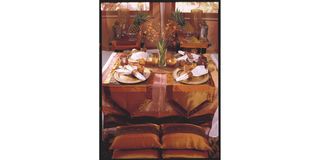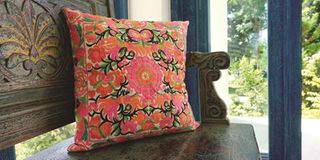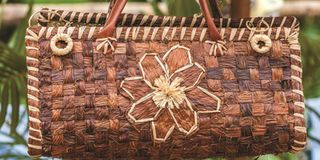
There is much more to Swahili decor than the famous intricate hand-carved centuries-old doors.
| Pool Nation Media GroupDN2
Premium
Swahili-inspired decor: Here’s how to do it right
What you need to know:
- There are several factors to put to mind regarding Swahili-inspired décor.
- The pieces are all crafted by hand by skilled artisans who have mastered these unique crafting techniques.
When most people think of Swahili-inspired styling, what readily comes to mind is the hand-carved centuries-old doors that are famous in the Coastal region. Yet there is much more to it than these intricate doors, pieces you can incorporate into the styling of your home.
There are several factors to put to mind regarding Swahili-inspired décor. To begin with, the pieces are all crafted by hand by skilled artisans who have mastered these unique crafting techniques.
These pieces are also crafted from natural materials. Expect a lot of natural hardwoods (mvule is a favourite), sisal, pure metals, intricate patterns, rustic accessories and natural textures.
The combination of hand crafting and use of natural materials makes for bespoke pieces, and due to the effort that goes towards creating them, they are priced on the higher side, therefore be prepared to dig deeper into your pocket when you are ready to invest.
Also to bear in mind is that Swahili-inspired decor is heavy to the look and to the touch. It easily upsets the cohesion in a space, and can sometimes feel out of place and mismatched.
Tacky, even. Incorporate the décor pieces in moderation and with a lot of thought to the styling you already have going on in your space.
That said, here are some suggestions on how to style your home with Swahili-inspired decor:
#1. Hand-carved hardwood pieces
Just as there are hand-carved doors, you can have just about any hand-carved furniture or accent piece in your home. Consider hand-carved headboards for your bed that are extra tall (the standard headboard size is 3 feet. Go for something taller for that wow effect). Also consider a home bar with hand-carved doors. You can also incorporate some hand carving into pieces you already have in your home to jazz them up.

You can incorporate some hand carving into pieces you already have in your home to jazz them up.
Say, some hand-carving on the feet of your bed, your dining table and dining table chairs. Or your end tables. Your TV or hallway console. A shelving unit. Maybe on your footstools or your living room coffee table.
Make you get a bonafide carver to do the work for you, otherwise you will irreparably ruin your furniture. Away from furniture, accessories also present a styling opportunity. Think of hand-carved frames for your full-length rectangular floor mirrors or the smaller round mirrors that are hooked to a wall. This will also work for your picture and artwork frames.
#2. Outdoor chairs
Swahili-styled chairs can also go on your balcony, your verandah or your garden. These outdoor chairs have the signature Swahili carvings and may be crafted with all wood or with cotton yarn for the seating and the backrest. (The Swahili call it the tradition al ‘Jeuri’ chair.) The yarn adds a welcome dimension of style.
Another favourite option is to have a daybed with the classic carvings, plush cushions and throw pillows, and a canopy. Everything about a daybed as outdoor furniture feels so extra, so cozy and so inviting.
Remember to keep your outdoor furniture away from the harsh elements of weather – direct sunlight, rain – as these will ruin the wood, cushions and pillows.
#3. Decorative and throw pillows
Swahili throw pillows stand out for their ornate hand-stitched finishing, embroidery and styling elements. The Swahili ‘leso’ – also known as ‘kanga’ – is the Coastal equivalent of Ankara.
This beautiful fabric can also be used to dress your decorative and throw pillows. The styling guide with these vibrant pillows is the same for any other type of pillow: complement colours, prints and sizes to create a playful mix on your couch and bed.

The styling guide with these vibrant pillows is the same for any other type of pillow.
#4. Rustic accessories
What would Swahili decor be without the lanterns? These rustic lanterns are usually made from upcycled brass, and can be gold, silver or different shades of burnt brown. Some also have stained glass. They are absolutely gorgeous pieces.
One way to style lanterns is to cluster three or five (odd numbers) on the floor, say, near your TV console. Cluster them in different sizes and different styles for extra va-va-voom.
Another way is to display them as individual pieces on your shelves, mantle, in your guest washroom and any other space you display accessories. Other brass accessories that can borrow from the Swahili culture are wall plates and lighting pendants.
#5. Hand-plaited mats and woven baskets
The mats are what the Swahili refer to as ‘mkeka’, a basket is ‘kikapu’. These mats are hand-plaited from palm leaves. The palm leaves are dried to give the stands different and vibrant colours. Aside from mats, the palm leaves are also used to make baskets (something similar to the ‘kiondoo’, that are woven from sisal).

These mats are not plush, so they are more an aesthetic piece than a functional piece.
Important to take away is that these mats are not plush, so they are more an aesthetic piece than a functional piece. They also don’t do well with extended exposure to water or moisture. But, they are light and fold easy, making them easy to move around.
Use them to style an area that needs to be defined but which does not sit people. Say, your entryway console. Or in your bedroom, in the area where your shoe rack sits. Or a smaller one as a doormat.
You can also layer them with anti-slip rubber padding to create some cushioning, then use them on your balcony, your entryway, your corners or in a reading nook.
The baskets can be used to hold potted houseplants, to organise extra throw blankets and throw pillows in the living room, as laundry baskets in the bedroom or to hold your child’s toys.
@_craftit




